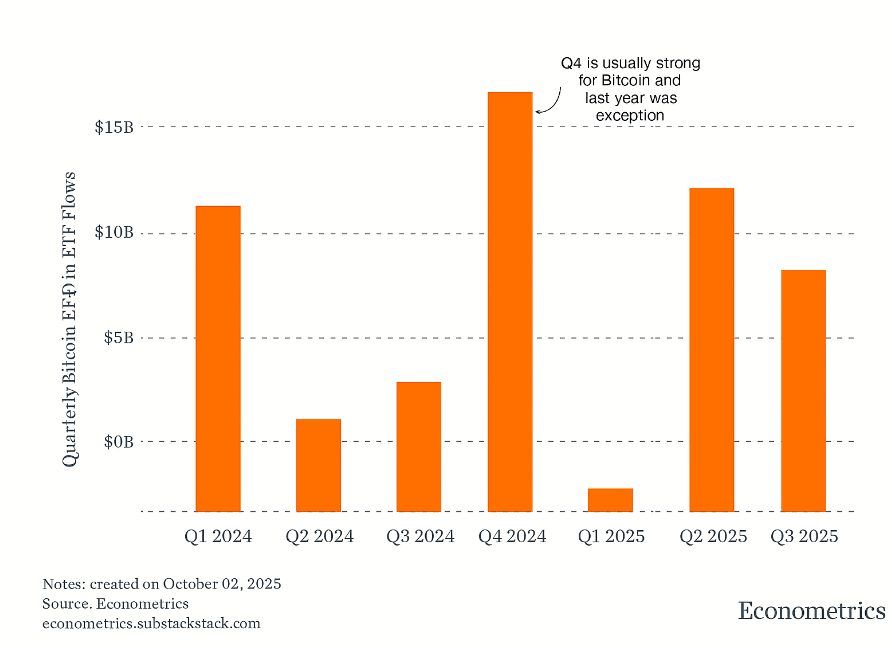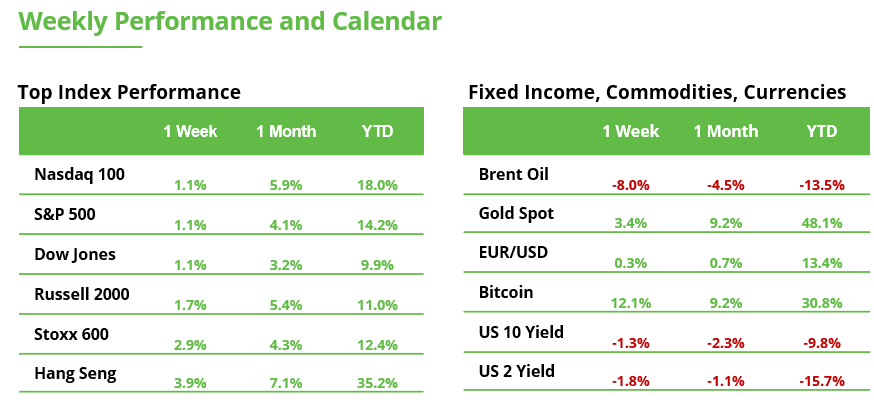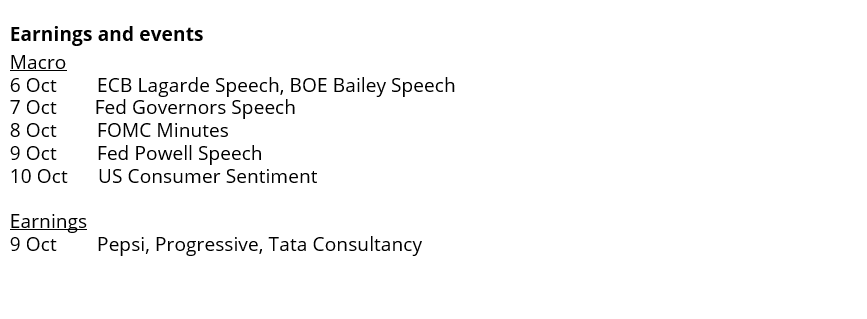Analyst Weekly, October 6, 2025
After a quiet few months, Bitcoin might be gearing up for its favorite seasonal trade: the fourth-quarter comeback. Crypto’s best three-month stretch historically starts right about now, with median gains above 50% from October through December. The setup looks familiar: yields are falling, volatility is low, and traders are once again hunting for risk-on assets as the Fed’s easing cycle gains traction.
Bitcoin Q4 2025 Outlook
Bitcoin enters the fourth quarter with strength, coupled with signs of caution. October has earned its “UpTober” reputation, with double-digit gains in most cycles since 2013. The post-halving dynamic and the psychological component of traders expecting rallies could act as catalysts. Still, while the asset remains within a structurally bullish technical move, we observe some classic signs of maturity. Although projections indicate that an extension toward 150,000 is possible, each additional leg increases the risk of exhaustion. On-chain indicators confirm this ambivalence, as the MVRV Z-score remains far from historical peaks, but long-term holders are selling and whales are beginning to reduce exposure.
Meanwhile, the tokenization wave is gaining speed. Stablecoins surpassed $300 billion in market capitalization for the first time, with quarterly growth outpacing many traditional asset classes. Narratives to watch include “agentic” payments driven by AI with stablecoins as the base layer, interoperability among multiple issuers and platforms, and new regulatory tensions from Hong Kong to Europe. In parallel, CME is expanding its derivatives offering (with Solana and XRP options this October, and the promise of 24/7 trading in 2026), while the SEC’s simplification in ETF approval opens the door to products based on assets far less liquid than bitcoin.
Altogether, this draws a familiar late-cycle picture. When altcoins outperform BTC, when memecoins enter ETFs, when infrastructure stories dominate headlines, it is more often a symptom of maturity than the start of a new phase. Nothing prevents one last bullish leg, the market could well set new highs in Q4, but the bigger risk is that a macro shock or an equity market downturn coincides with signs of crypto exuberance, turning euphoria into volatility.
Thus, the fourth quarter combines seasonal and structural tailwinds with growing evidence that the cycle is in its advanced stage. The test will be whether institutional flows and the momentum of tokenization can offset the weight of macro risks and investor overconfidence.

Healthcare’s Checkup: From Policy Pain to Potential Gain
Healthcare stocks just got a much-needed shot in the arm. The sector, which has trailed the S&P 500 for most of the past two years, surged after news of a US–Pfizer deal that could reset expectations on drug pricing and tariffs.
Under the agreement, Pfizer agreed to lower prices on Medicaid drugs in exchange for three years of tariff relief, a surprise move that could cause other pharma giants to follow suit.
Investor Takeaway: With Pfizer pledging $70B in new US investments, agreeing to lower drug prices, and the White House shelving 100% drug tariffs, the sector’s policy headache is easing. Other firms like Johnson & Johnson, AstraZeneca, and Roche are following suit, highlighting a broader “Made in America” healthcare trend that could support jobs and capacity expansion. For long-term investors, that’s a dose of stability the market’s been waiting for. For the past few years, drugmakers have faced constant uncertainty over how aggressively Washington might try to cut or control prescription drug prices. That uncertainty, about potential caps, negotiations, or tariffs, have made investors hesitant to buy healthcare stocks, because it was unclear how far the government would go.
A Rally on the Prescription Pad
Healthcare stocks rallied last week, with big names like Pfizer, Eli Lilly, and AbbVie leading, as traders bet on a Q4 rebound. The policy boost is sparking hopes for a “catch-up trade” as investors rotate into lagging defensive sectors.
SMID Cap Healthcare Stocks Get a Tax-Time Boost
Washington’s new One Big Beautiful Bill (OBBB) will give smaller health and biotech firms a major tax break. Companies can now immediately expense their R&D costs, instead of spreading them out over years.
That’s a game changer for smaller healthcare innovators, especially for the ones that spend heavily on research but don’t yet have giant profits to offset it. It effectively lowers their tax bill and frees up cash, letting them invest faster in new drugs and technologies.
Stocks That Stand Out
Stocks could gain most from this setup are the ones that spend most on R&D, such as:
Roviant Sciences ($ROIV) – heavy R&D focus and pipeline-driven model.
ACADIA Pharmaceuticals ($ACAD) – smaller-cap biotech with high R&D-to-sales ratio.
Arrowhead Pharmaceuticals ($ARWR) – early-stage biotech leveraging RNAi tech, strong beneficiary of upfront expensing.
Dynavax Technologies ($DVAX) – vaccine developer with substantial US-based R&D.
Jazz Pharmaceuticals ($JAZZ) – strong reinvestment profile, mid-cap name with domestic operations.
What Could Keep the Rally for the Sector Going
Beyond politics, fundamentals are improving. The new R&D expensing rules from this summer’s tax bill allow healthcare and biotech firms, especially for small and mid-cap players, to write off research costs immediately, boosting near-term profitability. Add in Fed rate cuts and a backdrop of falling inflation, and the setup looks increasingly supportive for long-duration sectors like health and biotech. Finally, ETF flows have been negative, suggesting many investors already capitulated, a contrarian setup.
Beyond Weight Loss: GLP-1s Power a Lasting Pharma Transformation
GLP-1s have reshaped pharma into one of the most powerful growth stories in global markets, creating tech-style winners like Eli Lilly and Novo Nordisk. Lilly is up nearly 400% in five years and Novo remains far ahead of peers, showing that even with short-term pullbacks and job cuts, the long-term trajectory is intact. That is because the leaders aren’t just riding a one-drug boom: they are broadening access with oral formulations, defending share in obesity and diabetes despite pricing and formulary noise, and building durability with growth in oncology and immunology.
For investors, that means GLP-1s have clearly shifted from a disruptive niche into a diverse, multi-franchise growth engine, where the opportunity lies in striking the right balance between chasing disruptive upside and anchoring in stability.


This communication is for information and education purposes only and should not be taken as investment advice, a personal recommendation, or an offer of, or solicitation to buy or sell, any financial instruments. This material has been prepared without taking into account any particular recipient’s investment objectives or financial situation and has not been prepared in accordance with the legal and regulatory requirements to promote independent research. Any references to past or future performance of a financial instrument, index or a packaged investment product are not, and should not be taken as, a reliable indicator of future results. eToro makes no representation and assumes no liability as to the accuracy or completeness of the content of this publication.






